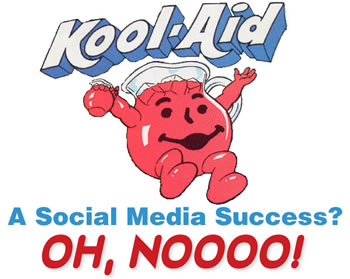 Kool-Aid Says Their Social Media Marketing Is Great…But What Numbers Are They Looking At?
Kool-Aid Says Their Social Media Marketing Is Great…But What Numbers Are They Looking At?
I just read an article on Kool-Aid’s social media prowess and it left me shaking my head. Why are so many trade publications giving brands hi-fives for their social media efforts when in reality, things aren’t so great.
First, let’s drop some real data as a starting point. Kool-Aid has over 3 millions fans on Facebook. But they have less than a half of 1 percent engagement. Yup…a fraction of 1% of their “fanbase” actually choose to interact in any capacity with the brand.
I couldn’t even find a Twitter profile and if I couldn’t find it with a quick 5 minute search, no one else will either.
As for Instagram, I did find them there. They have a whopping 233 followers.
These are hardly earth-shattering stats. Actually they’re the kind of numbers I would expect to be fired for if I was delivering them for my clients. Why would an article be written trumpeting Koo-Aid as a champion in social media?
Let’s look at what was said in the article. It’s a very interesting case study on the social blindness of brand managers.
The article quotes Tiffany Tamplin, who is the Senior Director of Refreshment Beverages at Kraft which is the parent company of the Kool-Aid brand.
Let’s start with the fanbase. Like many brands, Kool-Aid initially measured success by the size of its social footprint not necessarily the quality of its fans. Working with LoudDoor, a market research and audience-targeting platform, Kool-Aid discovered that its Facebook fans were predominately 18-year olds and not moms who actually buy the product. Recalibrating its media buy, Kool-Aid was able to attract the right fans at a cost well below its prior efforts.
Applause! I’ve been telling brands for quite some time to ignore the number of fans. It’s wholly irrelevant. 90%+ of that number will never return to your Facebook page and Facebook has turned off the spigot, so understand you’re working with a number that’s a mere fraction of that. Your reach will never extend to that myth of a fanbase, so ignore it.
I’ve also told brands to make sure that you’re creating content for your social audience. Content isn’t a one size fits all fix. You may be very surprised to learn that your social audience varies dramatically from your traditional advertising demographic.
What I really applaud Tamplin about is the fact that she is actually running social ads. I’m a firm believer that if you’re posting content on Facebook without running a media buy to support it, then you’re just giving your advertising agency a means to employ staff. Posting content on Facebook without ad support is just a waste of time.
Social as a marketing mix tool plays a key role in creating a personal, meaningful and memorable experience with our brand. It allows us to create a 1:1 experience that is of real substance; an experience you want to share with others. Television, Print and OLA helps us get the word out, but social is where the natural expression and passion of our brand advocates can be harnessed.
Harnessed? What exactly does she mean when she says this? I’m concerned that a lot of brand managers don’t realize that on social media they don’t control their brand any longer. As scary as that may seem, the consumer now holds the power. That “1:1 experience” that she describes above is a real relationship. One where people will now tell you exactly what they feel.
In order to truly develop the relationship that she speaks of, you have to create those experiences that people actually care about and want to share. She’s right. It must be of “real substance”. It has to be authentic. It can’t be brandspeak. So I’d like to ask Tamplin if this is content of substance that creates an experience that I’d like to share with my friends and family?
Don’t let the numbers on the post above fool you. Sure, the post got a few thousand likes and received some shares. But remember, that post was delivered to a potential audience of 3 Million people. Yes, we know Facebook suppresses the reach of content, but even at an exposure rate of 15% the engagement on this post is deplorable.
Analyzing our Facebook fan base conversation, our agency VSA Partners, could see that we were pulling in a lot of Male teenagers who probably appreciate the brand’s appearance on Family Guy but are not the people who are going out and buying our product.
However, we knew our core consumer was online so we worked with LoudDoor to identify her and better understand her so we could start a social dialogue she would respond to. The net result was significant fan growth this year, exceeding the 3million fan mark. Today Kool-Aid ranks within the top 10% of branded site.
Huh?? Tamplin’s first response I applauded. I did so because she earlier acknowledged that a successful social profile isn’t about the size of the following but in this response, she seems to be heralding the fact that Kool-Aid has so many fans that they’re in the top 10%. Top 10% of what?? Who cares? What does 3 Million fans mean? I’ll tell you, it means you are failing to reach, stimulate or compel 99.9% of those people to have any interaction with your brand whatsoever!
Question…if appearing on Family Guy brought in a lot of kids who won’t be buying the product…why did Kool-Aid appear on the show? That’s like someone going fishing yet not having any desire to eat fish?
Tamplin also stated that her intention was to start a dialogue with Kool-Aid’s core consumer so that they would respond. However, when you look at Kool-Aid’s Facebook page, the comment level is EXTREMELY low and the replies from the brand are basically non-existent. So where’s the dialogue?
When asked about Kool-Aid’s future in social media Tamplin said that she expects to continue with her stellar social media marketing!
Our plan is to grow and expand upon the fantastic momentum we started this past year
As Kool-Aid is enjoying engagement at a fraction of 1%, seeing basically non-existent social dialogue from it’s 3 Million+ fans on Facebook, has no Twitter presence to be found and posts such amazingly compelling content like the image below on Instagram, it shouldn’t be too hard to grow from this point.
